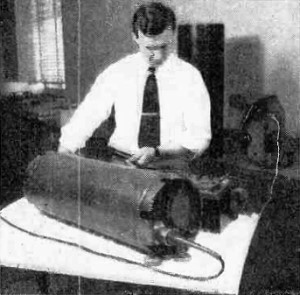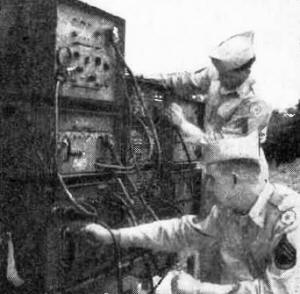New Military Phone System
|
|
It's kind of hard to believe that by 1955, the military was still very dependent on wired radio communications for field use. This system, heralded as a technological breakthrough for its ability to operate over a distance of 200 miles between units (with the aid of repeater cells), weighed in at 178 pounds and "occupies only five and a half cubic feet of space." A big part of the weight was probably due to the lead-acid batteries that powered it, although there was likely an ability to hook it up to a generator. A modulated carrier is credited with being able to stuff 12 channels into a single twisted pair of wires. No mention is made of whether any sort of encryption (scrambling) of the signals was used. No mention was made of the model number. If anyone out there can identify it, please let me know. New Military Phone System A new, portable, GI telephone system, which can handle three times as many conversations over a single cable as comparable Korea and World War II systems, has been developed for the U.S. Army Signal Corps by Bell Telephone Laboratories. Basic equipment for the new telephone system is contained in units about the size of large suitcases, which can be handled by only one or two men and can be stacked. The "carrier" principle used for the new system allows twelve conversations to share the same cable by using a different frequency for each channel. The system, providing for twelve simultaneous conversations, can be used for distances up to 200 miles. Another, a four-channel system, can be used for four simultaneous conversations at distances up to 100 miles. Several of these wire systems linked together can form a communication system of about a thousand miles. They may also be operated in conjunction with a GI radio relay system developed at Bell Laboratories. Miniaturized Parts Reduce Size
Bell Labs technician tests repeater housed in water-tight cylinder. Unit restores level of transmitted signals every six miles. These "stackable" units are part of system which can carry twelve conversations simultaneously up to distances of 200 miles. Recently developed miniaturized parts can be credited with the sharp reduction in size and weight of the new equipment. The earlier, four-channel unit, for example, weighed funds and occupied twenty cubic feet of space. Complete with its power supply, the new four-channel terminal weighs 178 pounds and occupies only five and a half cubic feet of space. The cable used for the systems can be strung on poles, laid on the ground, or buried. New types of repeaters also have been designed to be used at intervals in order to restore the level of the transmitted signals and extend the range of the systems. Important new features facilitate testing and maintenance while all regular channels are in service. A portable test set provided with the twelve-channel system contains a transistor oscillator. Field equipment designed by Bell for the Army is tested for its ability to withstand desert heat and arctic cold. It is subjected to vibration, bounce and shock tests, 100 percent humidity, and wind and rain. The new military carrier systems have recently been placed in production by the Western Electric Co., manufacturing unit of the Bell System.
Posted August 19, 2019 |
|



